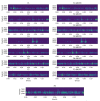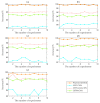An Imbalanced Fault Diagnosis Method Based on TFFO and CNN for Rotating Machinery
- PMID: 36433352
- PMCID: PMC9692439
- DOI: 10.3390/s22228749
An Imbalanced Fault Diagnosis Method Based on TFFO and CNN for Rotating Machinery
Abstract
Deep learning-based fault diagnosis usually requires a rich supply of data, but fault samples are scarce in practice, posing a considerable challenge for existing diagnosis approaches to achieve highly accurate fault detection in real applications. This paper proposes an imbalanced fault diagnosis of rotatory machinery that combines time-frequency feature oversampling (TFFO) with a convolutional neural network (CNN). First, the sliding segmentation sampling method is employed to primarily increase the number of fault samples in the form of one-dimensional signals. Immediately after, the signals are converted into two-dimensional time-frequency feature maps by continuous wavelet transform (CWT). Subsequently, the minority samples are expanded again using the synthetic minority oversampling technique (SMOTE) to realize TFFO. After such two-fold data expansion, a balanced data set is obtained and imported to an improved 2dCNN based on the LeNet-5 to implement fault diagnosis. In order to verify the proposed method, two experiments involving single and compound faults are conducted on locomotive wheel-set bearings and a gearbox, resulting in several datasets with different imbalanced degrees and various signal-to-noise ratios. The results demonstrate the advantages of the proposed method in terms of classification accuracy and stability as well as noise robustness in imbalanced fault diagnosis, and the fault classification accuracy is over 97%.
Keywords: continuous wavelet transform; convolution neural network; data expansion; imbalanced data; synthetic minority oversampling technique.
Conflict of interest statement
The authors declare no conflict of interest.
Figures
















Similar articles
-
Improved Variational Mode Decomposition and CNN for Intelligent Rotating Machinery Fault Diagnosis.Entropy (Basel). 2022 Jun 30;24(7):908. doi: 10.3390/e24070908. Entropy (Basel). 2022. PMID: 35885131 Free PMC article.
-
Noise Eliminated Ensemble Empirical Mode Decomposition Scalogram Analysis for Rotating Machinery Fault Diagnosis.Sensors (Basel). 2021 Dec 4;21(23):8114. doi: 10.3390/s21238114. Sensors (Basel). 2021. PMID: 34884120 Free PMC article.
-
A Novel Fault Diagnosis Method for Rotating Machinery Based on a Convolutional Neural Network.Sensors (Basel). 2018 May 4;18(5):1429. doi: 10.3390/s18051429. Sensors (Basel). 2018. PMID: 29734704 Free PMC article.
-
Machine learning for fault analysis in rotating machinery: A comprehensive review.Heliyon. 2023 Jun 22;9(6):e17584. doi: 10.1016/j.heliyon.2023.e17584. eCollection 2023 Jun. Heliyon. 2023. PMID: 37408928 Free PMC article. Review.
-
A Review of Early Fault Diagnosis Approaches and Their Applications in Rotating Machinery.Entropy (Basel). 2019 Apr 17;21(4):409. doi: 10.3390/e21040409. Entropy (Basel). 2019. PMID: 33267123 Free PMC article. Review.
Cited by
-
A Methodology of Condition Monitoring System Utilizing Supervised and Semi-Supervised Learning in Railway.Sensors (Basel). 2023 Nov 9;23(22):9075. doi: 10.3390/s23229075. Sensors (Basel). 2023. PMID: 38005464 Free PMC article.
-
Method for Diagnosing Bearing Faults in Electromechanical Equipment Based on Improved Prototypical Networks.Sensors (Basel). 2023 May 4;23(9):4485. doi: 10.3390/s23094485. Sensors (Basel). 2023. PMID: 37177689 Free PMC article.
-
Editorial for Special Issue: Machine Health Monitoring and Fault Diagnosis Techniques.Sensors (Basel). 2023 Mar 27;23(7):3493. doi: 10.3390/s23073493. Sensors (Basel). 2023. PMID: 37050553 Free PMC article.
References
-
- Sharma S., Tiwari S.K., Singh S. Integrated approach based on flexible analytical wavelet transform and permutation entropy for fault detection in rotary machines. Meas. J. Int. Meas. Confed. 2021;169:108389. doi: 10.1016/j.measurement.2020.108389. - DOI
-
- Zhang L., Zhang J., Peng Y., Lin J. Intra-Domain Transfer Learning for Fault Diagnosis with Small Samples. Appl. Sci. 2022;12:7032. doi: 10.3390/app12147032. - DOI
-
- Vashishtha G., Kumar R. Recent Advances in Machines and Mechanisms. Springer; Singapore: 2023. Feature Selection Based on Gaussian Ant Lion Optimizer for Fault Identification in Centrifugal Pump; pp. 295–310.
Grants and funding
LinkOut - more resources
Full Text Sources

